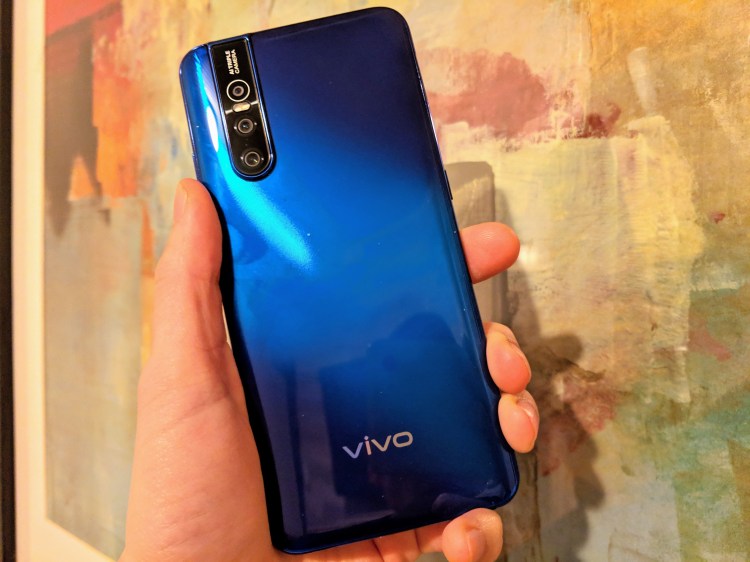A little over a year ago, Dongguan, China-based electronics giant Vivo debuted the Vivo Nex S, a nearly bezeless smartphone that tweaked the conventional candy bar formula in two important ways: with a front-facing camera that elevated from a flush compartment and a fingerprint scanner embedded beneath display glass. Neither was perfect — we pointed out a few of the glaring flaws in our review last August — but they moved the needle forward like few design elements before them. If nothing else, the Nex S demonstrated an ingenious — if imperfect — means of maximizing screen real estate without a notch, pinhole cutout, or motorized slider.
Now Vivo’s back with a refined, slightly cheaper take on its original conceit: the Vivo V15 Pro. Like the Nex S, the V15 Pro has a mechanized front-facing camera — this one packing a 32-megapixel sensor. And other refinements abound, like slimmer bezels (it has a 91.64 percent screen-to-body ratio, compared with the Nex’s 91 percent), a triple rear camera with a 48-megapixel sensor, and a suite of AI-powered software features.
Spoiler alert: It’s solid — really solid. But as with the Nex S, a few niggling issues make it tough to recommend.
Design
The V15 Pro looks uncannily similar to the Nex S, which I’ve come to believe was an intentional design decision. It might technically slot somewhere between the V11 and X23 in Vivo’s product portfolio, but it feels more like a spiritual Nex S successor — and that’s not at all a bad thing.
June 5th: The AI Audit in NYC
Join us next week in NYC to engage with top executive leaders, delving into strategies for auditing AI models to ensure fairness, optimal performance, and ethical compliance across diverse organizations. Secure your attendance for this exclusive invite-only event.
To that end, the bezels measure just 1.75mm around the sides of the screen and 2.2mm on the top and bottom (the thinnest of any Vivo phone to date), and the whole thing weighs about 185 grams. That’s lighter by a hair than the 199-gram Nex S, but heavier than the 174-gram iPhone X and the 163-gram Galaxy Note 9.
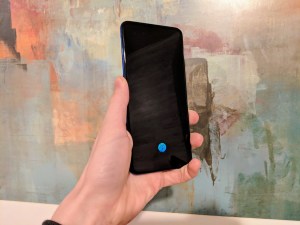
While the V15 Pro’s 157.25mm x 74.71mm x 8.21mm glass-and-plastic body would certainly stretch anyone’s definition of “compact,” it’s smaller than the Nex (162mm x 77mm x 7.9mm) — a welcome improvement, in my book. And while there’s less screen real estate (6.39 inches compared with 6.59 inches), I’m thankful I don’t have to shimmy my hand up the sides to reach the top of the screen as I did with the Nex S, and that I can tap every button — the power button and volume rocker on the right and the action button on the left — one-handed.
The Vivo feels more top-heavy than the Nex S, which makes intuitive sense — the top portion houses the mechanical front-facing camera and triple-sensor rear camera, in addition to a 3.5mm headphone jack. That’s not the only compromise made in pursuit of an all-screen design — the V15 Pro isn’t waterproof or dust-resistant, and it doesn’t support wireless charging. Vivo anachronistically opted for a microUSB port rather than USB Type-C port, which in my case prompted a convenience store run for a cable type I hadn’t used in years. And, inexplicably, only certain models of the V15 Pro (in Hong Kong, Taiwan, Singapore, and Russia) have an NFC chip, which means contactless payments are a no-go unless you import a unit from one of those regions.
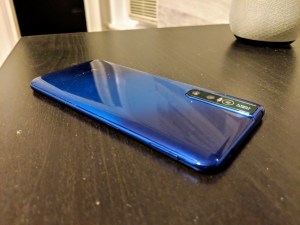
On the plus side, there’s a microSD slot onboard (in case you exhaust the 128GB of onboard storage), along with the accoutrements you’d expect in a 2019 midrange phone: Bluetooth 5.0, an electronic compass, a gyroscope and accelerometer, an ambient light sensor, and GPS. And although it’s becoming less of a novelty as newer and better flagships arrive, there’s still something futuristic about a nearly bezeless panel without any notches to speak of.
The V15 Pro’s flavor — a Super AMOLED display — has a 19.5:9 aspect ratio with Full HD+ resolution and 100 percent P3 color gamut coverage. I wouldn’t call the viewing angles or brightness jaw-dropping, by any stretch, but as with the Nex S, the razor-thin curved edges are the real attraction. And they don’t disappoint.
Flipping the V15 over reveals the “Spectrum Ripple” finish, a gradient design that shimmers gorgeously in direct sunlight. Two finishes are available at launch: Topaz Blue and Coral Red. Our review unit is the former.
Cameras

Above: A selfie captured with the Vivo V15 Pro.
Vivo’s getting in on the triple-camera trend with the V15 Pro — like Huawei, LG, Samsung, and others before it. But unlike most of the competition, it has a secret weapon: A 48-megapixel sensor (more on that later). It’s one of the first smartphones on the market with a sensor that size, following hot on the heels of the Honor View20.
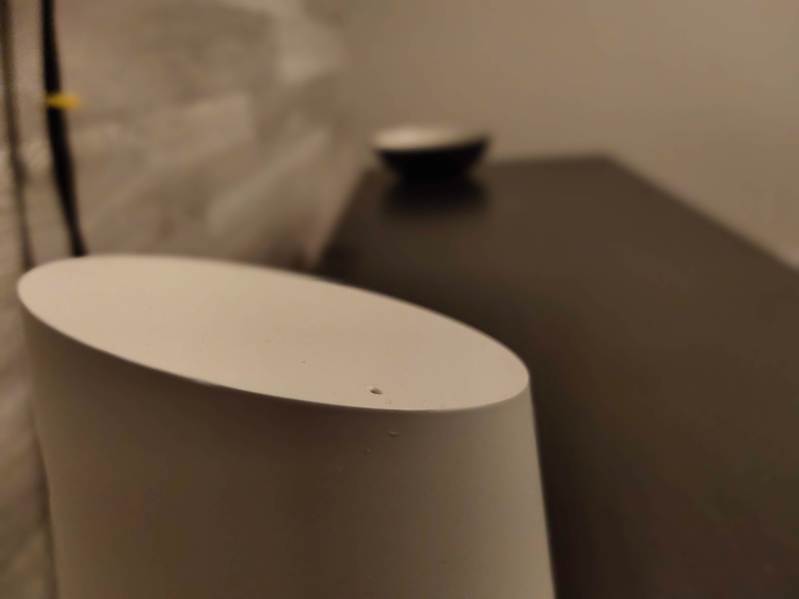
Above: Illustrating bokeh with the Vivo V15 Pro.
Complementing this 1/2.5-inch sensor (which has an f/1.8 aperture and 0.8-micron pixel size, for those keeping count) is an 8-megapixel wide-angle sensor and a 5-megapixel depth sensor, the latter of which Vivo claims improves bokeh quality (the effect that blurs out backgrounds while keeping the foreground in focus). The 48-megapixel sensor can produce 48-megapixel photos, as advertised, but — more compellingly — it’s able to combine four adjacent pixels into a single 1.6-micron large pixel to improve overall picture quality. In tandem with a Night Sight-inspired AI Super Night Mode that snaps several pics at different exposures and combines them to achieve better brightness and clarity, this helps the V15 Pro hold its own in dark environments, ostensibly, at least.

Above: A 48-megapixel image taken with the Vivo V15 Pro.
I’ll be the first to admit I’m a dilettante when it comes to photography. To my untrained eyes, though, the V15 Pro produces better shots than your average smartphone — shots on par with my trusty Pixel 3, I’d go so far as to say. It’s not as color-accurate, mind you — it leans on the cooler end of the color spectrum — but photos it captures are crisp, sharp, and full of detail. I’m even more impressed by the V15 Pro’s portrait mode, which locks focus just as quickly and consistently as the Pixel 3, and AI Super Night Mode, which comes admirably close to Night Sight levels of artificial brightness.

Above: AI Super Night Mode.
The wide-angle camera works as advertised, in my limited testing. Its 120-degree field of view (108 degrees after accounting for distortion) indeed squeezes in more periphery than your average camera — a tad more, in fact, than the LG V40‘s wide-angle sensor (107 degrees).

Above: A wide-angle shot.
Camera AI
Vivo has imbued the V15 Pro’s camera app with AI — lots and lots of AI. AI Scene Identification identifies 17 different scenes — including people, nighttime settings, flowers and plants, and food — and automatically adjusts certain settings accordingly. (I left this enabled for the most part.) Face Beauty — a carryover from the Nex S — somewhat creepily analyzes things like skin type, tone, gender, and age and attempts to smooth away wrinkles and blemishes. And AI Portrait Framing suggests the optimal angle for portrait shots, taking into account factors like distance, orientation, and position of in-frame faces.
Unfortunately, Scene Identification is no more transparent on the V15 than it was on the Nex S — it’s difficult to tell which settings are being adjusted and why. The Face Beauty feature is still a mixed bag, as well — skin with the effect applied takes on a blurred, pastel-toned appearance I’m not especially fond of. And for the life of me, I can’t get the AI filter recommendation feature — which is supposed to make a selection automatically, depending on lighting and other factors — to switch from the default setting.
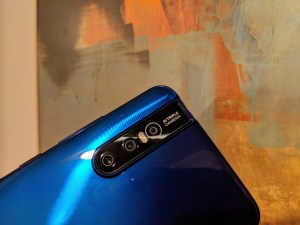
As on the Nex S, the V15 Pro’s selfie cam is embedded in a plastic strip that extends from the top of the phone whenever an app calls Android’s camera API. Exit the app, and it retracts. (Vivo says it re-engineered the elevating front camera with a micro-stepping motor that performs more “accurate” movements than before, and that’s more reliable and durable.) It’s a quick (under two seconds) and nearly silent affair, but should you wish to mask the mechanical whir with one of three cheesy sound effects, Vivo’s got you covered.
All that aside, the 32-megapixel front sensor takes pretty darn good selfies. I’m impressed by the amount of light it manages to capture indoors and at night — not to mention the level of detail. Portraits snapped with the V15 Pro come out more neutral (on the color spectrum) and much sharper than those taken with my Pixel 3 (which has an 8-megapixel front camera) — so much sharper, in fact, that if I took selfies on the regular (I don’t), it might become my new go-to for that purpose.
Camera fanatics will be pleased to know that the V15 Pro’s camera app has options coming out the wazoo. There’s standard fare, like panorama and timelapse modes, and a Snapchat Lens-like AR Stickers feature that superimposes cat whiskers, glittery stars, and other cute cosmetics onto your skin. In selfie mode, you can trigger snapshots the conventional way, by tapping the on-screen shutter button, or by holding up your palm or saying “Cheese.” And in professional mode, settings like ISO, shutter speed, white balance, and autofocus can be configured and reconfigured to your heart’s content. (I found the balance tool, which uses the phone’s accelerometer to help line up shots, particularly handy.)
Performance
The Nex S was the cream of the crop when it came to raw performance — its Qualcomm Snapdragon 845 system-on-chip, 8GB of RAM, and 4,000mAh battery made sure of that. The V15 Pro settles for less, but it makes the most of what it has.
Under the hood’s a Snapdragon 675, an octa-core processor built on an 11-nanometer LLP paired with either 6GB or 8GM RAM, depending on the make and model. Two Kryo 460 cores clocked at 2GHz handle the heavy lifting, while six 1.7GHz efficiency cores address less performance-intensive tasks. There’s a 14-bit Spectra 250 image signal processor onboard, which supports still image capture up to 32 megapixels and up to 4K video capture; an Adreno 612 discrete graphics chip; and Qualcomm’s X15 modem, which is theoretically capable of reaching download and upload speeds of 600Mbps and 150Mbps, respectively.

We fired up Geekbench to get an objective sense of performance, and the results were good — not blow-your-socks-off good, mind you, but respectable. The Vivo V15 Pro notched a single-core score of 2,388 and a multi-core score of 6,472, putting it just behind the Vivo Nex S on the single-core charts and ahead of the Nokia 8 on the multi-core leaderboard.
Benchmarks aside, the V15 Pro’s zippy enough day-to-day, with little noticeable lag. Apps occasionally take longer to launch than I’d like, not-so-coincidentally when I’m juggling an email client, Facebook, Slack, and a Google Doc at once. But touch latency, a notorious bugbear of budget handsets, is nowhere in sight. Ditto for scroll lag — the multitasking menu, which sometimes bugged out and stuttered on the Vivo Nex S, is as smooth as glass on the V15 Pro. I’ve got to hand it to Vivo — whatever sort of byte equivalent to nitrous they’ve injected into FunTouch 9, the V15 Pro’s skin atop Android 9.0 Pie, it’s working wonders.
I can’t complain about the battery life, either. MicroUSB issue aside, the V15 Pro’s 3,700mAh power pack easily lasts a full day on a charge with light usage, and about five to six hours when I really tax it — i.e., flip the brightness to maximum and catch up on my ever-growing Netflix backlog. Vivo claims it recharges super quickly (up to 24 percent from zero in just 15 minutes) if you choose to use the included wall adapter, thanks to what the company has dubbed “dual-engine fast charger” technology. I’ll have to take its word for it — my review unit shipped with a European-style two-prong plug, which wasn’t of much use in my New York City apartment.
Fingerprint sensor and speakers
The V15 Pro joins the growing list of phones with under-display optical fingerprint sensors, including Huawei’s Porsche Design Mate RS, Vivo’s Nex S, the Oppo R17, and the Xiaomi Mi 8 Explorer Edition. Here’s a quick primer: When one of your digits makes contact with an illuminated spot on the lower portion of the screen, a camera beneath the glass snaps a picture. Then a machine learning model analyzes roughly 300 fingertip characteristics (for example, the distance between finger ridges) and stores the unique pattern to memory.
Vivo says the tech — which is now in its fifth generation — snaps higher fingerprint pixel densities and employs “more sophisticated” algorithms, which explains why it’s much more reliable than the Nex S’ scanner. That’s not to suggest it’s flawless; if my finger’s off-center by so much as a millimeter, the scanner can’t get a read. But compared with the Nex S’ scanner, which seemed to work only about a quarter of the time, it’s a huge improvement.
In any case, it’s better than Vivo Nex’s bottom-firing speaker, which is muddy, distorted, and generally underwhelming. It’s a step down from the Nex S’ bottom speaker, which was middling at best, and falls short of the high mark set by the likes of Samsung and LG. Also disappointing: no stereo audio.
Software
I briefly touched on Funtouch OS earlier (no pun intended). I’m pleased to report that it has gotten better.
There’s still a bit too much bloatware for my liking, and I don’t think I’ll ever be a fan of the iOS-inspired settings pulldown or notification shade. (Incoming alerts are rounded, transparent, and larger than average, which makes scrolling through them a lot more tedious than it needs to be. It also has the unintended side effect of making the buttons beneath notifications — like the Reply button under a Gmail alert — more difficult to reach one-handed.) But in the upgrade from Android 8.1 Oreo to Android 9.0 Pie, Vivo has made a few quality-of-life improvements.
Funtouch now has a facial recognition unlock option, which was sorely missing from the Nex S. Also new is Smart Wake, which lets you launch apps with gestures (drawing a “W” on the lock screen, for example, opens WhatsApp). Returning features include Smart Click, which lets you reassign the volume rocker to perform a function like recording audio or launching the camera, and Smart Split, which optionally displays messages from Facebook Messenger, Android Messages, and other apps in a floating window.
Jovi
A big focus in the latest Funtouch is AI. Jovi, Vivo’s AI assistant, serves you contextually sensitive cards based on the time of day, your location, and information you voluntarily supply it. (They’re viewable from a dashboard to the far left of the home screen — reminiscent of Samsung’s Bixby Home.) You’ll see things like a weather report if it’s about to rain, a reminder to rest if you haven’t set a morning alarm, a tally of the total steps you’ve taken, and upcoming (and past) sporting events in which you’ve expressed an interest.
That’s not the only trick up Jovi’s sleeve. Jovi can differentiate between close to a half a billion products in images, much like Google Lens and Bixby Vision, and recommend where to buy the recognized things at “almost 100” ecommerce platforms (like Shopee and Zalora). I didn’t have the best luck with it — Jovi correctly identified a diet soda can and a bag of chips but thought a book’s ISBN number was either a “sequential power switcher” or a gigabit switch. As with most object-detecting AI systems, I’m assuming it’ll get better with time.

Above: Jovi, Vivo’s intelligent assistant.
At least it’s easy to access. A single tap of the V15 Pro’s action button activates Google Assistant, and two taps launches Jovi’s computer vision feature (Jovi Image Recognizer). Speaking of Google Assistant, it recognizes more than a dozen Funtouch-specific commands, like “OK Google, clear trash on i manager” and “OK Google, clear background application.” They’re useful in a pinch, if not the easiest to remember.
The Chinese variant of Jovi, which I wasn’t able to try myself, is apparently a bit more capable — it recognizes over 600 voice commands in Mandarin, allowing you to do things like change settings and accept money from friends in WeChat group conversations.
Conclusion
The V15 Pro isn’t for everyone, much like the Nex S. Who needs a pop-up 32-megapixel selfie camera? What good’s a triple rear shooter with a 48-megapixel sensor? And do those eye-popping specifications really make up for the loss of a USB Type-C port? After spending some quality time with the V15 Pro, I’m no closer to answering those questions than I was when it arrived in the mail.
One thing is certain — you’ll be hard-pressed to find another phone like it. And for all of its AI and software misses, the V15 Pro is a big improvement over the prototypical Nex S. But I’m afraid that its uniqueness comes at the significant cost of convenience. If you live in the U.S., there’s no word yet on pricing and availability, and it’s not compatible with every major carriers’ bands.
My advice? Hold off. Later today, Samsung’s expected to announce at least three new flagship smartphones, and Mobile World Congress — the newsiest smartphone convention of the year — begins on February 25. If you can spare a few weeks, something just as good — and perhaps more importantly, much more easily obtainable — will likely catch your eye.
